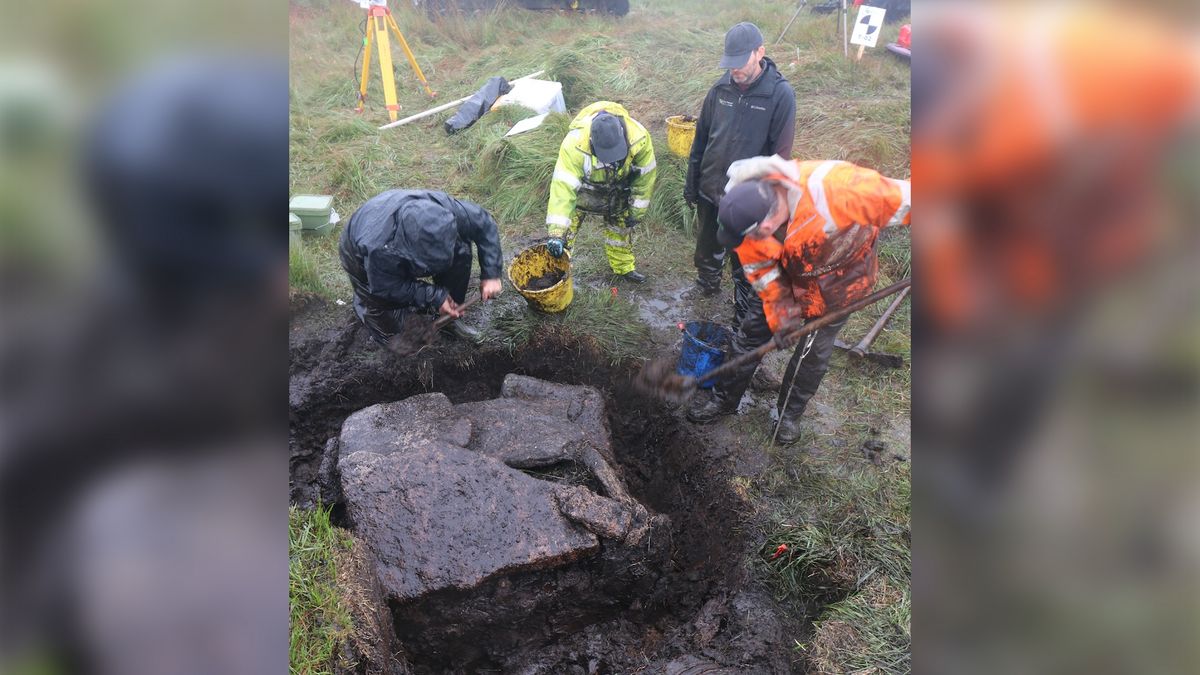A “stunning” tomb found on an isolated moor in southwest England could help archaeologists understand what life was like 4,000 years ago in the Bronze Age.
Originally discovered in May, the burial chamber began eroding out of the peat at Dartmoor National Park and was excavated in August, according to a statement from the park. The tomb, which measures about 3.3 feet (1 meter) square, was covered with three large, granite stones. This cist-type burial was likely used around 1800 B.C., based on the radiocarbon dating of charcoal from inside the tomb.
Archaeologists lifted the granite stones and discovered numerous pieces of well-preserved wood, as well as an additional 12 inches (30 centimeters) of fill. The team managed to move the entire tomb to a laboratory, where painstaking micro-excavation will reveal the complete contents of the grave.
The cist tomb was found in a small wetland area within a larger wooded landscape on Cut Hill, which, at 1,978 feet (603 m), is one of the highest peaks on Dartmoor. The newly discovered grave joins a similar one excavated in 2011 on Whitehorse Hill at Dartmoor.
The Whitehorse Hill burial dates to between 1730 and 1600 B.C. and contained the cremated remains of a young-adult. Because this burial was sunk into the peat, where a lack of oxygen can inhibit decomposition, archaeologists found many organic artifacts that would not normally be preserved, including a brown bear pelt and textiles, as well as a necklace of more than 200 beads crafted out of clay, shale, tin and amber.
Related: ‘Untouched’ Bronze Age tomb containing human remains and a mysterious stone found in Ireland
Although other cist burials have been discovered at Dartmoor, most of them were excavated before modern archaeological techniques allowed for close examination of their contents. That means Whitehorse Hill and the new Cut Hill tomb could provide unprecedented information about what life was like in Early Bronze Age England. For example, the Whitehorse Hill amber beads suggest the local people were far from isolated; they traded and acquired materials from as far away as the Baltic region.
While the micro-excavation of the tomb proceeds slowly, analyses of the landscape around the burial have been completed.
There were intense bursts of human activity at Cut Hill in prehistoric times, according to Ralph Fyfe, an environmental scientist at the University of Plymouth in the U.K. “These weren’t people who were suddenly building burial monuments and reorganising the landscape around them; they were living in a place they were intimately familiar with and knew a lot about,” Fyfe said in the statement.
“Cut Hill offers stunning views but is often mist-covered and ethereal,” Laura Basell, an archaeologist at the University of Leicester, said in the statement. “While surveying, I pondered whether Bronze Age people saw this place as a liminal zone between earth, water and sky and perhaps life and death.”
The Cut Hill cist is nearly twice as large as the one found at Whitehorse Hill. So the micro-excavation stage involves “very detailed work that’ll take time to complete, but we’re all very excited about it,” Lee Bray, an archaeologist at the Dartmoor National Park Authority, said in the statement. “It’s a stunning discovery with the potential to be every bit as fascinating as the finds at Whitehorse Hill.”
Once the comprehensive excavation of the tomb’s contents in the lab is complete, any discovered artifacts will be conserved, analyzed and published.















%20(2)%20(1).jpg)



Discussion about this post